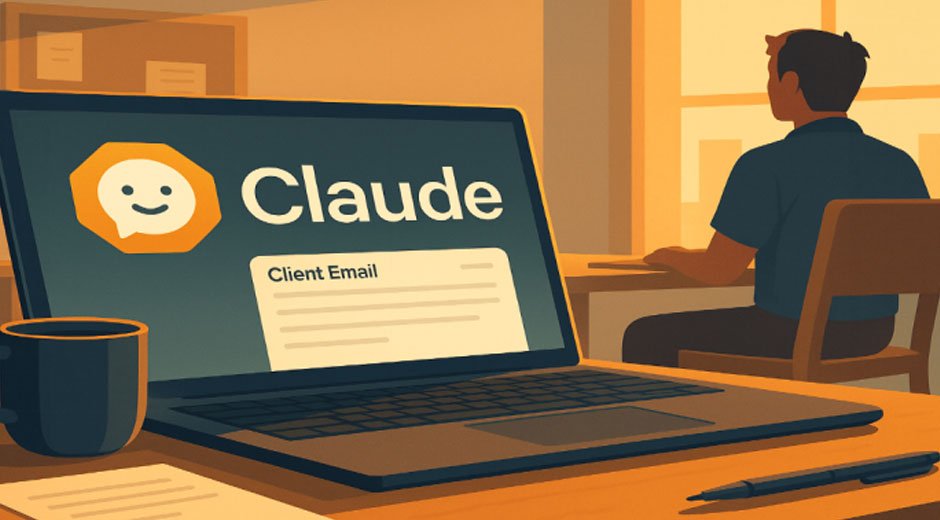Skip to the good bit
ToggleWhen a Freelancer Realized Claude Could Handle His Inbox
For months, Alex, a mid-level freelancer juggling multiple clients, lived on caffeine and late-night emails. Weekends blurred into weekdays. Drafting proposals, following up with clients, and clarifying scope turned into hours of unpaid labor. He thought that was just the price of independence.
Then he tried Claude. The AI handled the drafting, softened tone, and structured his replies better than any template he’d ever written. Unlike basic GPT software he had tried before, Claude adjusted for nuance, tone, and context. For a developer-turned-freelancer like Alex, it was like hiring an assistant without the monthly cost.
Suddenly, weekends were his again.
How Claude Took Over Client Communication
The experiment started small. Alex asked Claude to draft a follow-up email to a client who hadn’t responded in two weeks. Instead of the usual dry nudge, the email came out empathetic yet firm — and the client replied within hours.
Encouraged, Alex fed it longer chains: multi-step onboarding notes, timelines, even delicate explanations about scope creep. Claude produced drafts that felt human, not mechanical. He still reviewed before sending, but the hours saved were massive.
Soon, his “writing time” shrank from 15 hours a week to under five.
Why This Shift Mattered for a Freelancer
Freelancers know the trap: you’re not only doing the work, you’re constantly selling, clarifying, and managing clients. It’s invisible labor — and it eats entire weekends.
By letting Claude handle the heavy lifting in emails, Alex could:
- Spend more time on paid work, less on admin.
- Respond faster, improving client trust.
- Keep tone consistent across all communications.
It wasn’t about perfection. It was about speed, clarity, and freeing up brainpower for the real work.
The Email Prompts That Worked Best
Alex refined his system with a few reliable prompts. Here are the ones that consistently produced useful drafts:
| Situation | Prompt Example | Result |
| Follow-up | “Draft a polite follow-up to a client who hasn’t replied in 10 days. Keep it short, professional, with a friendly nudge.” | Replies doubled |
| Scope creep | “Write an empathetic but firm email explaining why extra work requires renegotiation of the contract.” | Saved hours of awkward drafting |
| Onboarding | “Create a structured welcome email for a new client, outlining next steps in 3 clear bullet points.” | Clients impressed with professionalism |
With these, Claude wasn’t just saving time — he was shaping perception.
The Mental Shift: From Drowning to Control
By mid-month, Alex noticed something more important than efficiency: he felt in control again. Instead of reactive midnight replies, he had pre-drafted notes waiting. Instead of staring at a blinking cursor on Sunday evening, he could actually log off.
That sense of control — of not being ruled by inbox chaos — changed how he approached his entire business.
Chatronix – Where Freelancers Test AI Side by Side
Alex didn’t stop with Claude. He wanted to compare results across different models — ChatGPT for idea generation, Gemini for structured briefs, Grok for informal tone. Doing that in separate tabs was exhausting.
That’s when he tried Chatronix’s multi-model workspace. It gave him six models in a single chat, plus 10 free queries to experiment.
The real unlock was Turbo mode: Chatronix instantly generated outputs from all models, then pulled them into One Perfect Answer. No more cross-checking. No more wasting time figuring out which draft was “least robotic.”
For Alex, that meant:
- Faster testing of tones across clients.
- Automatic comparisons without leaving the window.
- Confidence that the best draft was already waiting.
It was the same lesson as with Claude: the value wasn’t just time saved, but stress removed.
Bonus Prompt for Freelancers
Here’s the exact prompt Alex now uses before any new client project:
“Draft a professional intro email to a new client. The goal: build trust, outline next steps clearly, and keep the tone friendly but confident. Include bullet points for clarity.”
With this in his pocket, he never starts from scratch again.
This. THIS is my favorite Claude use case.
Take an ungodly amount of data and preferences, shove it into Claude, ask for an interactive decision-making bot, ask for scoring and reward mechanism, personalize as necessary.
Brands will now calibrate for human+AI decisions. pic.twitter.com/uhSZGQ8Brx
— Allie K. Miller (@alliekmiller) June 27, 2024
From Weekend Work to Real Balance
Alex’s story isn’t about outsourcing humanity. It’s about stripping away the friction that drains energy and time. Claude drafting client emails wasn’t a gimmick — it was a shift in how he ran his freelance business.
He still reviews, still personalizes, still adds the human touch. But instead of spending Sundays buried in admin, he spends them with friends, with family, with a notebook sketching out ideas for new projects.
The freelancing life didn’t change. His approach did.
And for once, the inbox stopped feeling like a boss.







